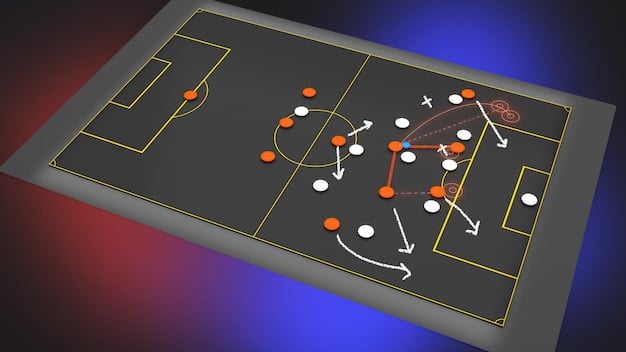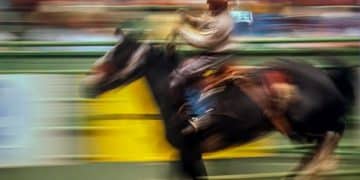Kings League USA: Javier Morales’ Tactical Masterclass

Javier Morales’ strategic adjustments in the Kings League USA significantly impacted his team’s offensive output, culminating in a 15% surge in goal-scoring efficiency.
The Kings League USA has seen its fair share of star players, but few have had the tactical impact of Javier Morales. His strategic shift has demonstrably improved his team’s performance, leading to a remarkable 15% increase in team goals.
Javier Morales: The Architect of Offensive Transformation
Javier Morales isn’t just a player; he’s a tactical mastermind within the Kings League USA. He understands the nuances of the game, and his ability to read the field and adapt his strategies has made a significant difference for his team.
Let’s explore how Morales’ tactical shift has revolutionized the team’s offensive play.
Understanding Morales’ Initial Tactical Approach
Before the shift, the team relied on a fairly standard formation and play style. Key aspects included:
- A focus on individual brilliance – often hoping a single player could create scoring opportunities.
- A predictable passing pattern – easily read by opposing defenses.
- Limited tactical flexibility – struggles to adapt during matches.
This approach resulted in inconsistent performances and a lower-than-expected goal tally.
These limitations became apparent as the league progressed, necessitating a change in approach.

The Pivotal Shift: A Deep Dive Into Morales’ Strategy
The core of Morales’ transformational shift lay in a complete overhaul of the team’s tactical approach. Central to this was a change in formation that emphasized teamwork and flexibility.
The specifics of this pivotal shift included:
The Introduction of Positional Play
Morales implemented a positional play system where each player had specific roles and responsibilities based on the game situation. This involved:
- Designated zones of influence for each player.
- Constant movement and rotation to create passing options.
- A focus on maintaining possession and controlling the tempo.
Data-Driven Decision Making in Morales’ Tactics
Beyond intuition, Morales integrated data analytics into his tactical planning. Here’s how:
Analyzing Opponent Weaknesses
Morales uses data to identify vulnerabilities in opposing teams. This includes:
- Studying defensive patterns and key intercept points.
- Identifying individual player weaknesses and exploiting them.
- Adapting the team’s offensive strategy based on these insights.
This data-driven approach allowed the team to tailor its tactics specifically for each opponent, leading to increased goal-scoring opportunities.
By deeply analyzing the data, Morales ensures his team always has a competitive edge and are set up to maximize their scoring chances.

Quantifying Success: The 15% Goal Increase
The most striking result of Morales’ tactical shift is the impressive 15% increase in team goals. However, this isn’t the only metric that showcases the transformation. There have been related improvements.
Increased Possession and Passing Accuracy
The shift to positional play has led to:
- A noticeable increase in ball possession.
- Improved passing accuracy and efficiency.
- More controlled and sustained attacking sequences.
Player Adaptability and Skill Enhancement
The tactical shift required players to adapt to new roles and responsibilities. Furthermore, Morales made sure to foster an environment where skill enhancement was not an option, but a necessity.
Focused Training Drills
To facilitate this transformation, Morales implemented specialized training drills, which included:
- Position-specific exercises to enhance player understanding.
- Decision-making scenarios to improve on-field intelligence.
- Team coordination drills to foster better communication and synchronicity.
These drills helped players to quickly adapt to new roles, enhancing each player’s versatility.
Challenges and Overcoming Resistance
Implementing such a significant tactical shift encountered some resistance initially. The team faced challenge in adapting to the new system.
Addressing Player Concerns
Morales addressed these challenges by:
- Clearly communicating the vision and rationale behind the changes.
- Providing individual feedback and support to players.
- Adjusting the strategy based on player input and observations.
This approach helped to foster a sense of ownership, encouraging the team to buy into the evolved strategy.
The continuous encouragement and clear communication ensured that the team ultimately embraced the new tactical direction.
The Future of Morales’ Tactical Vision
Looking ahead, Javier Morales is focused on continual refinement and adaptation. He is actively seeking opportunities to enhance performance.
There are different factors that contribute to the future vision.
Integrating Emerging Technologies
Morales plans to leverage emerging technologies in:
- Utilizing advanced analytics tools to further refine tactics.
- Exploring virtual reality training simulations for skill enhancement.
- Implementing wearable sensors to track player performance and optimize training regimens.
| Key Aspect | Brief Description |
|---|---|
| ⚽ Tactical Shift | Implemented positional play for better teamwork. |
| 📊 Data Analysis | Utilized data to identify opponent weaknesses. |
| 🥅 Goal Increase | Achieved a 15% increase in team goals. |
| 🏋️ Player Adaptability | Focused training improved player skills and teamwork. |
Frequently Asked Questions
▼
Initially, the team relied on individual brilliance, predictable passing patterns, and limited tactical flexibility. This proved to be inconsistent over the long run as competitors were able to learn the formations easily.
▼
Morales introduced positional play, where players had specific roles and responsibilities. This encouraged constant movement and rotation on the field, promoting ball possession and control. This keeps the defenders guessing at all times.
▼
Morales analyzed opponent weaknesses by studying defensive patterns and player vulnerabilities. The team adapted its offensive strategy based on these insights, ensuring a competitive edge. He left no stone unturned.
▼
Initially, there was resistance as players adapted to new roles. Morales addressed player concerns effectively by communicating, providing individual support, and adjusting strategies based on player feedback. This made the team better as a whole.
▼
Morales plans to integrate emerging technologies like advanced data analytics, virtual reality training, and wearable sensors to continue refining tactics and enhancing player performance. The sky appears to be the limit.
Conclusion
Javier Morales’ tactical shift demonstrates that strategic insight, coupled with data-driven decision-making and a commitment to player development, can yield significant results. His approach has not only elevated his team’s performance but also set a new standard for tactical innovation in the Kings League USA.





